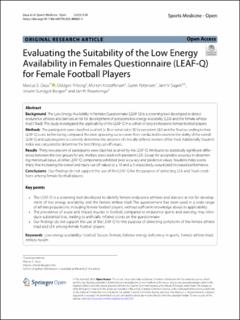| dc.contributor.author | Dasa, Marcus Småvik Tutu | |
| dc.contributor.author | Friborg, Oddgeir | |
| dc.contributor.author | Kristoffersen, Morten | |
| dc.contributor.author | Pettersen, Gunn | |
| dc.contributor.author | Sagen, Jørn Vegard | |
| dc.contributor.author | Sundgot-Borgen, Jorunn | |
| dc.contributor.author | Rosenvinge, Jan Harald | |
| dc.date.accessioned | 2024-01-05T09:13:56Z | |
| dc.date.available | 2024-01-05T09:13:56Z | |
| dc.date.created | 2023-08-24T12:25:01Z | |
| dc.date.issued | 2023 | |
| dc.identifier.citation | Sports Medicine - Open. 2023, 9(2023), Artikkel 54. | en_US |
| dc.identifier.issn | 2198-9761 | |
| dc.identifier.uri | https://hdl.handle.net/11250/3110047 | |
| dc.description | This article is licensed under a Creative Commons Attribution 4.0 International License, which permits use, sharing, adaptation, distribution and reproduction in any medium or format, as long as you give appropriate credit to the original author(s) and the source, provide a link to the Creative Commons licence, and indicate if changes were made. The images or other third party material in this article are included in the article's Creative Commons licence, unless indicated otherwise in a credit line to the material. If material is not included in the article's Creative Commons licence and your intended use is not permitted by statutory regulation or exceeds the permitted use, you will need to obtain permission directly from the copyright holder. | en_US |
| dc.description.abstract | Background: The Low Energy Availability in Females Questionnaire (LEAF-Q) is a screening tool developed to detect endurance athletes and dancers at risk for development of persistent low energy availability (LEA) and the female athlete triad (Triad). This study investigated the applicability of the LEAF-Q in a cohort of sixty professional female football players.
Methods: The participants were classified as at risk (≥ 8) or not at risk (< 8) for persistent LEA and the Triad according to their LEAF-Q score, before being compared. Receiver operating curves were then conducted to examine the ability of the overall LEAF-Q and subcategories to correctly determine the presence of clinically defined markers of the Triad. Additionally, Youden’s index was calculated to determine the best fitting cut-off values.
Results: Thirty-two percent of participants were classified as at risk by the LEAF-Q. We found no statistically significant differences between the two groups for any markers associated with persistent LEA. Except for acceptable accuracy in determining menstrual status, all other LEAF-Q components exhibited poor accuracy and predictive values. Youden’s index scores imply that increasing the overall and injury cut-off values to ≥ 10 and ≥ 5 respectively, would yield increased performance.
Conclusions: Our findings do not support the use of the LEAF-Q for the purpose of detecting LEA and Triad conditions among female football players. | en_US |
| dc.language.iso | eng | en_US |
| dc.subject | athlete health | en_US |
| dc.subject | female | en_US |
| dc.subject | female athlete triad | en_US |
| dc.subject | football | en_US |
| dc.subject | low energy availability | en_US |
| dc.subject | relative energy deficiency in sports | en_US |
| dc.subject | soccer | en_US |
| dc.title | Evaluating the suitability of the Low Energy Availability in Females Questionnaire (LEAF-Q) for female football players | en_US |
| dc.type | Peer reviewed | en_US |
| dc.type | Journal article | en_US |
| dc.description.version | publishedVersion | en_US |
| dc.rights.holder | © The Author(s) 2023 | en_US |
| dc.source.pagenumber | 9 | en_US |
| dc.source.volume | 9 | en_US |
| dc.source.journal | Sports Medicine - Open | en_US |
| dc.identifier.doi | 10.1186/s40798-023-00605-4 | |
| dc.identifier.cristin | 2169339 | |
| dc.description.localcode | Institutt for idrettsmedisinske fag / Department of Sports Medicine | en_US |
| dc.source.articlenumber | 54 | en_US |
| cristin.ispublished | true | |
| cristin.fulltext | original | |
| cristin.qualitycode | 1 | |
